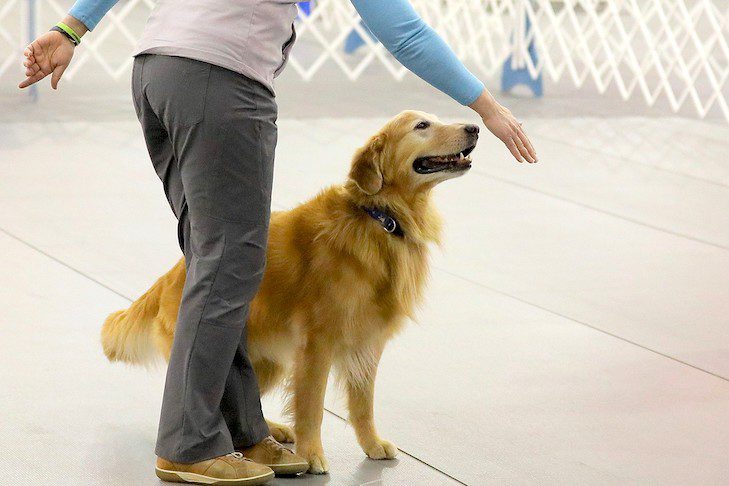
Bii o ṣe le kọ aja rẹ ni aṣẹ “Wá”: rọrun ati kedere
Awọn akoonu
- Why teach a dog the command “Come!”
- Correct command execution
- Teaching the command “Come to me!” for daily use
- Teaching the command “Come to me!” according to OKD
- How to motivate a dog to follow the command “Come to me!”
- Kini lati ṣe lakoko ikẹkọ
- Exercises to help master the command “Come to me!”
- How to teach a dog the team “Come to me!”: advice from dog handlers
- Awọn idahun si awọn ibeere ti a beere nigbagbogbo
Why teach a dog the command “Come!”
The following phrase is popular among cynologists: “If your dog does not follow the command“ Come to me! ”, You can assume that you do not have a dog.” And indeed, when you see a confused, loudly screaming, running after a dog man on the street, it is difficult to recognize him as a real owner. Team “Come to me!” will prevent dog escapes and save the pet from risky acts. It is imperative to educate the animal. You should not turn the dog into a prisoner, forced to always walk on a leash, and daily walks into hard labor.
Walking a well-mannered, trained dog, on the contrary, will bring joy and satisfaction. Just imagine: you come to a park, forest or dog playground, let your pet off the leash, he frolics and plays freely, but at the same time you are sure that when you hear the command “Come to me!”, The dog will immediately come running to you. Understanding each other perfectly, both the owner and the dog will feel safe.
Important: Start training your puppy as early as possible, making sure he knows his name. If the pet does not respond to the nickname, he will not understand which of the phrases you uttered refer specifically to him. Finding out that the baby is aware of his name is not difficult: the dog will wag his tail, turn his head and walk in your direction. Once the basics of obedience are mastered, you can proceed to the study of the command “Come to me!”.
Correct command execution
To teach a dog the “Come to me!” team, the owner must clearly understand what it is and, accordingly, what to require from a pet. It is important to immediately train the dog to execute the command correctly, and not be content with the fact that he sometimes comes to you. Show firmness, confidence and act without haste.
Today, there are two correct versions of the command “Come to me!”:
- for everyday life – the dog approaches the owner and sits down;
- normative – the dog approaches the owner, then bypasses him clockwise and sits down at the left leg.
In both cases, the command “Come to me!” can be divided into 3 stages, which will need to be worked out sequentially:
- the pet comes to the owner;
- the dog sits opposite the owner, or makes a detour and sits at his left leg;
- the dog gets up and behaves freely after the owner has released it with the help of the cancel command – “Go!”, “Walk!”, “Good!” or other.
Having heard the command “Come to me!”, The dog should immediately react and resort to the owner. The dog throws any business and fixes attention on its owner. It is not enough that the pet runs up to you and immediately rushes back – he must linger nearby. The seat helps the dog to concentrate. After sitting near the owner, the fluffy pet can leave only when he is allowed to.
Teaching the command “Come to me!” for daily use
Start teaching the dog the command “Come!” best of all where she will not be distracted by loud extraneous sounds – in an apartment, house or a secluded corner of the park. In the first lessons, an assistant will be able to significantly help you.
Ask a friend to pick up the puppy. If the dog is already an adult, it must be kept on a leash. From your hands, give your pet a treat, praise or pet him. Now your assistant, together with the dog, slowly backs away at a distance of about 1-2 m, while the animal should not lose sight of you. Even if the dog immediately reaches out to you, you need to hold it. The puppy should be placed on the ground, while the adult dog remains on the leash.
Call the pet by name and kindly command: “Come to me!”. You can sit down and pat your thigh with your hand. This is where the role of the helper ends – he releases the dog so that it comes running to you.
When your pet approaches, praise him well and give him a treat. If the dog does not come, squat down and show him the treat – who would refuse a treat? Do not hold him for a long time, in order to avoid the appearance of persistent dislike for training, it is enough to take the pet by the collar and let it go.
Repeat this exercise 5 times, then take a break – walk and play with the dog as usual. The total training time per day should not exceed 15-20 minutes so that the pet does not lose interest in learning.
Note: How quickly a dog can complete this part of the task depends on its individual ability and breed. For example, Border Collies, Poodles, and German Shepherds catch on the fly, while Chihuahuas, Pugs, and Yorkshire Terriers take a little longer. Aboriginal breeds of dogs – the Afghan Hound, Basenji, Chow Chow – are by nature not very adapted to training.
In a couple of days, when the dog realizes that on command “Come to me!” it should approach you, increase the distance, bringing it to approximately 6 meters. Stroke the approaching dog first, and only then give a treat – he will get used to being handed and not running away right away. However, stroking too long is also useless, ideally, so that they last no more than 5 seconds. You can also pretend to inspect the paw and face of your pet, so that he thinks that approaching you is really important.
Continue to practice the command “Come to me!” during walks, call the dog to you every 10 minutes. At first, try to give a command when the pet is not busy with something interesting, so that he will surely react.
When the skill is well mastered, and the dog approaches you steadily, you can start landing. When the dog approaches, enter the command “Sit!”. Try to change the distance and place in which the training takes place so that the pet learns to follow the command “Come to me!” in any setting.
Teaching the command “Come to me!” according to OKD
If you are planning to teach your dog the “come!” in accordance with the General Training Course, you need to make sure that instead of landing opposite you, she makes a clockwise round and sits at her left foot.
To do this, call the dog in the same way as in the case of the “household” method, and then show your pet the treat hidden in your right hand. Hold the treat right next to your dog’s nose to keep him motivated. Now move your hand with the treasured piece behind your back, transfer it to your left hand and pull it slightly forward. The pet will follow the treat, thanks to which it will bypass you and take the right position. At the end, raise your hand up – the animal should sit down. If the dog does not sit down by itself, command: “Sit!”.
Don’t worry if your pet is confused at first. Over time, the dog will definitely understand what they want from it.
How to motivate a dog to follow the command “Come to me!”
By nature, dogs, and especially puppies, are extremely curious and active. They like to play, receive gifts and treats. They become attached to their owner and need attention. This is skillfully used by cynologists and savvy owners. When learning the command “Come to me!” conducted in a relaxed playful way, accompanied by praise and support, it does not frighten or tire the pet.
Basic ways to motivate your dog:
- delicacy. It is necessary not to feed, but only treat the dog with a delicacy. Choose the product that your four-legged friend loves very much, but rarely receives – when he executes a command. Treats do not replace meals. The piece should be small, because the smaller it is, the more the pet will want to get the next one. Food addiction is very strong, so a hungry dog is better trained than its well-fed counterpart;
- caress. When you call your dog to you, say as many affectionate words as possible to her, and when she runs up to you – admire! Stroke your pet – let him know that coming up to you, he will receive a charge of positive emotions. Then the dog will execute the command “Come to me!” with joy;
- the game. Every dog has a couple of favorite toys. Use the item as a treat – when the pet runs up to you, seeing the desired toy, be sure to play with it. From now on, he will expect the game, so it is important not just to wave a thing in front of him, but to fulfill his little dream. It is necessary to interrupt the entertainment program until the moment when it bores the dog so that the value of the game is preserved;
- fear of losing the owner. Fear is the strongest motivator. The dog must think that he can lose you forever if he does not obey. When practicing the “Come to me!” command, if the pet does not want to go to you, you can run away from him and hide, that is, “quit”. The fear of losing the owner must not be confused with the fear of punishment;
- the need for security. If the above tricks do not work, then your dog is a tough nut, and it’s time to move on to defensive motivation. The search for protection from the owner is a natural reaction of the animal to external threats. They can be jerks of a leash, a radio-controlled collar, suspicious sounds, shooting from a slingshot, a frightening stranger and other troubles organized in time.
A properly motivated dog will understand what the command “Come to me!” a real holiday awaits her – a treat, praise or a game, and in case of whims, she can be left bored alone. Training should be associated with positive emotions – this is the key to success! If you do not have the patience or time to deal with the dog, contact the cynologists. An animal must be able to behave in society so as not to pose a danger to it.
Kini lati ṣe lakoko ikẹkọ
When teaching a dog the command “Come!” it is better to familiarize yourself in advance with a list of typical mistakes that can negate all your efforts. Once you have made your pet dislike training, it will be difficult to get rid of it.
The first and most important rule – after you commanded: “Come to me!” Do not scold or punish your pet. If the dog ran up to you, but did something wrong on the way, you can’t shout at it, much less beat or drive it away. In the memory of the animal, the punishment will be associated with the command, and you will not want to execute it again.
A mistake often made by inexperienced dog breeders is to call a pet to itself with the command “Come to me!” at the end of the walk and immediately cling to the leash. At first glance, it may seem that this is logical and convenient. But from the point of view of the dog, the command will begin to mean tying and the end of the walk. Having called a four-legged friend to you, stroke him, scratch behind his ear, stand or play for a while, and then put on a leash. If you have time, take a short walk before returning home.
The owner is an indisputable authority for the dog. He should not repeat the same thing dozens of times in the hope of being heard. Team “Come to me!” very important and serious. She demands that the dog is distracted from any activity and reacts instantly. Give the command once, otherwise the dog will decide that it does not really matter when he responds: for the first, third or tenth time. If the dog ignored you, take him on a leash, repeat “Come to me!” later. If the pet knows the command well, but refuses to comply, reprimand him.
Until the dog learns the previous command, it is undesirable to switch to teaching a new one. The dog may begin to get confused and do not at all what is expected of it. Act consistently, and the result will not keep you waiting.
When you are just starting to learn the “Come!” command, make sure that the environment is fairly quiet and calm. It is useless to train a dog that is constantly distracted by children, animals, noisy companies or cars passing by. Do not say: “Come to me” – if you doubt that the pet will fit. In this case, alternative phrases are suitable, for example, “Come here!” or “Come!”, and the command “Come to me!” must be carried out implicitly from the first days of training.
You can not command an angry, dissatisfied or frightening voice, pick up calm and joyful intonations. Dogs are sensitive to the mood and emotions of their owners. Fluffy should want to approach you, not be afraid.
Body language is also of great importance. Some owners do not pay attention to this moment and take a threatening posture – they lean forward slightly, spread their arms and stare at the animal. Even the most loyal pet will want to run in the opposite direction! Turn sideways, bend your knees slightly, pat your thighs with your hands and demonstrate in every possible way that you will be glad when the dog approaches.
Exercises to help master the command “Come to me!”
Many dog owners want to diversify the process of training. Auxiliary exercises will help the pet quickly master the “Come to me!” command, and the game form will arouse the pet’s interest in classes. Learning at home and on the street has no fundamental differences, it should be encouraged in both cases. At the same time, the apartment has the opportunity to go to different rooms, and on a walk – to use the advantages of open space.
Workout at home
To practice at home, you will need a partner, a 1,5-2 meter long leash and small dog treats. As a reward, your favorite toy is also suitable, with which you can gradually replace the sweets.
Sit with an assistant on the floor, opposite each other, at a distance of the length of the leash. Get your dog on a leash. Pick up the free edge – at this time, your assistant should lightly touch the dog’s back. Call the pet by name and command “Come to me!”. Now begin to gently pull on the leash. The dog will reach out to you, and when he comes, be sure to praise him, treat him with a treat, stick your hand into the collar, stroke him.
Your friend will probably also want to be in charge – change places with him and hold your pet yourself. The helper should call the dog and repeat everything you did before.
When the animal no longer needs to be guided on a leash and responds well to the “Come!” command, move on to the next task.
Repeat the exercise without a leash – call your pet to you, let your friend let him go at this moment. Gradually increase the distance that the dog will need to overcome up to 3-4 meters.
Now complicate the task: while the assistant holds the dog, hide in the next room and give the command “Come!” loudly enough. from there. If the dog finds you, praise him and reward him with dessert. If he does not figure out what to do, go up to him, take him by the collar and take him to the place where you were hiding. Then do not forget about affection and treats. You can hide with a friend in turn. As a result, the pet will learn to find you in any part of the apartment.
Outdoor workout
To make the most of your time outdoors, take a friend, your dog, and a leash with you to a fenced-in area like a tennis court, school yard, or garden. Repeat the home exercise with a leash – you can squat.
When the skill of approaching you is already firmly established, let the pet off the leash and do not pay any attention to it. Choose a moment when he also does not think about you, command “Come to me!”. If your dog approaches you, reward him with treats, praise, and pets. If the pet does not respond, do not be discouraged – take him by the collar, lead him to the right place, and then praise and treat him. The exercise will be considered mastered when, on command, the dog will always come to you, no matter what he does.
How to teach a dog the team “Come to me!”: advice from dog handlers
Team “Come to me!” is one of the basic for the development of the dog. If you are engaged in training on your own, the recommendations of dog handlers may be useful to you.
- Training should not be noticeable to the puppy, let it be like a game. Do not tire the animal with frequent commands. Follow the rule: 1 day – 10 repetitions.
- Do not forget for what purpose your dog breed was bred. Often the reason why dogs do not follow the “Come!” command is a lack of physical activity. For example, hunting breeds – Beagle, Jack Russell Terrier, Russian greyhound – are very active by nature. Spending a lot of time locked up, animals try to catch up and run enough.
- Always be gentle with a dog that comes to you. If the command “Come to me!” will be used for subsequent punishment or any unpleasant actions, this will be the most effective way to train the dog not to respond to it. Almost all dogs do not like to be bathed and treated, but forcing them to come with a command is not a good idea. If you need to bathe your pet or give him medicine, approach him, take him by the collar and lead him to the right place.
- Regardless of age, start teaching your puppy the command “Come!” from the first days of its appearance in your home. It is easier for a kid to learn to respond to a call than for an adult dog. The age from 4 to 8 months requires special attention, when young pets begin to learn about the world around them. During this period, do not neglect the leash so that the puppy cannot ignore you and follow your commands.
- When the pet has mastered the command, you can stop giving food for each execution, but still do it often.
- If the dog decides to play catch-up with you – approaches, and then runs around you so that you cannot catch it – stop it. Make sure that the pet, approaching you, allows you to touch the collar before receiving a treat.
- In difficult and critical situations, keep the dog on a leash, and do not rely only on the command “Come!”. Calmly approach the animal and take it on a leash. Do not endlessly shout out a command or scare the dog, because then later it will be more difficult to catch it.
Awọn idahun si awọn ibeere ti a beere nigbagbogbo
Let’s analyze the most frequently asked questions related to the “Come to me!” command.
Is it possible to prepare a puppy for future training?
Puppies can learn the “come!” command as soon as they get comfortable in the house and begin to respond to their nickname. The following sequence of actions will help to approach this command: attract the dog’s attention, say: “Come!”, Place a bowl of food in front of it and praise it.
There is also a little trick: when you see that the puppy is already walking towards you, give the command “Come to me!” and reward him with a small treat or favorite toy.
Why does a dog follow the command “Come to me!” only at home?
It’s all about motivation. At home, a pet has much less temptations than on the street. The desire to explore the territory, meeting relatives, new people, intriguing smells, unusual objects – your “Come to me!” should outweigh everything. Offer your dog a reward that he will like.
Why is a dog not suitable when he is passionate about something?
Excitatory and inhibitory mechanisms operate in the central nervous system. During involvement in any process – chasing a cat, playing with dogs – the pet comes into a state of excitement. The “Come to me!” command, on the contrary, activates the braking process. The dog should be distracted from the current lesson, turn his attention to you and execute the command. Genetically, some dogs do this better than others. Usually these are service breeds: Rottweiler, Border Collie, Labrador Retriever.
The good news is that the ability to “brake” in time can be developed. Play an interesting game. When your dog gets excited, show him the treat. Now give any command that he learned earlier, such as “Down!” or “Sit!”. Praise your pet and give him a treat. Continue the game, but periodically take such breaks. Over time, the dog will learn to switch his attention to commands.
Why did the dog stop obeying as he grew up?
If, as a puppy, the dog learned to correctly execute the “Come!” command, and after a while began to rarely perform it or ignore it, this may be due to a certain stage of growing up. All dogs, to one degree or another, sometimes try to establish their own rules, to become the leader in your “pack”. Individuals at a transitional age especially like to compete for leadership – a male at 7-9 months, a female – before and during the first estrus. Be attentive to your pet, and, regardless of the results achieved earlier, practice the learned commands daily.
Do not forget that it is the owner who is the main source of happiness, love and new knowledge for the dog. Be generous emotionally, come up with different games and ways to please your furry. It is important not only to teach the dog the “Come!” command, but also to make her want to run to you!





